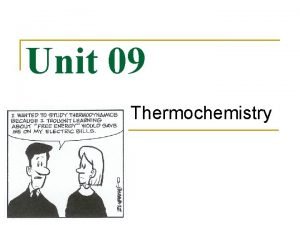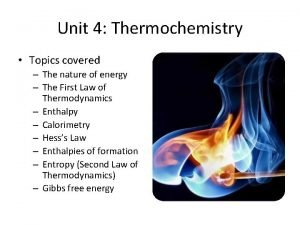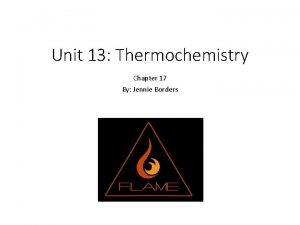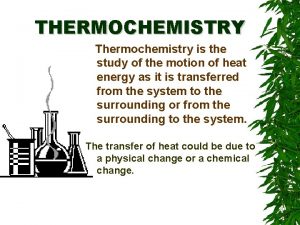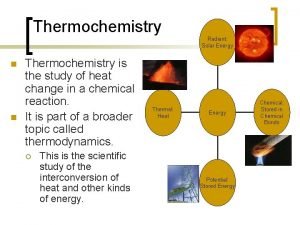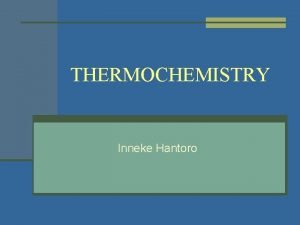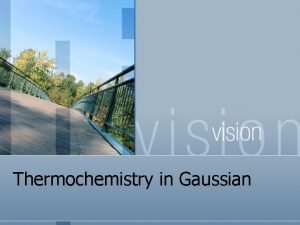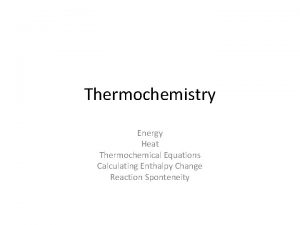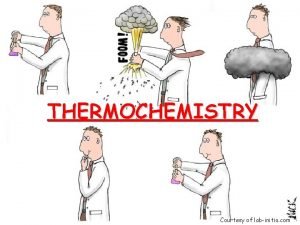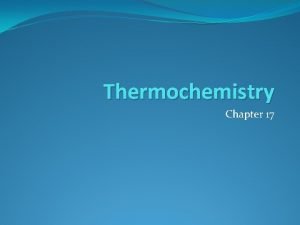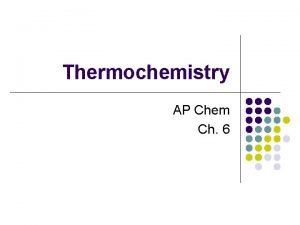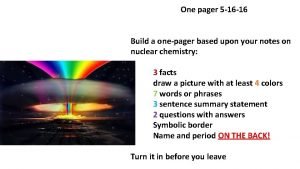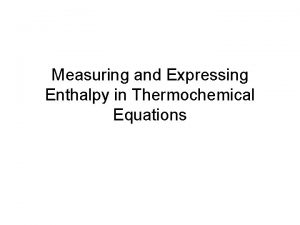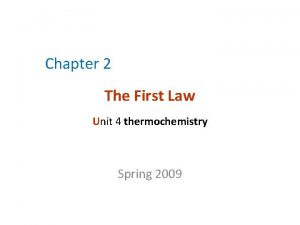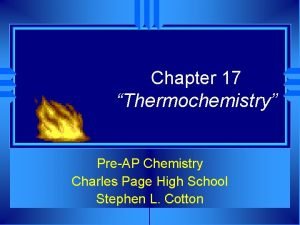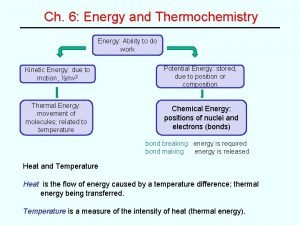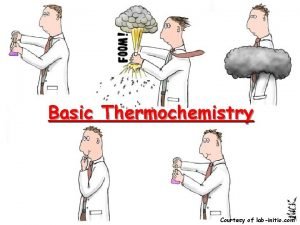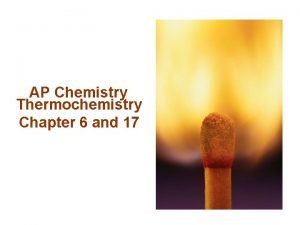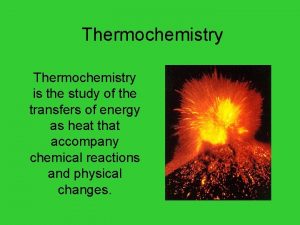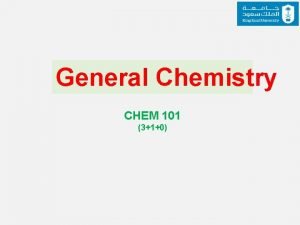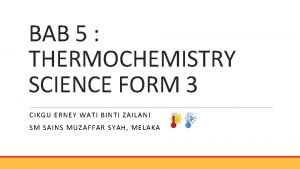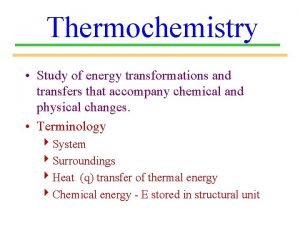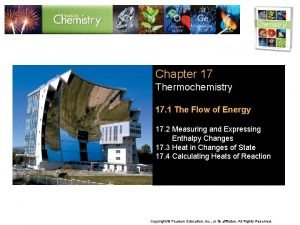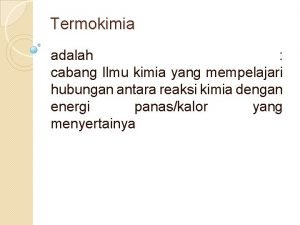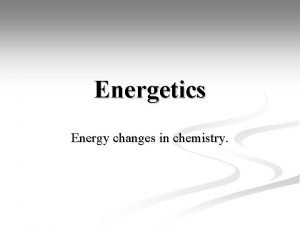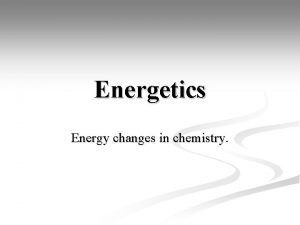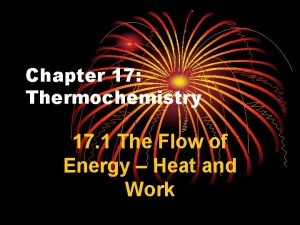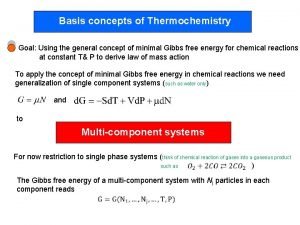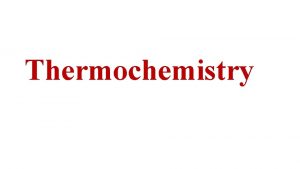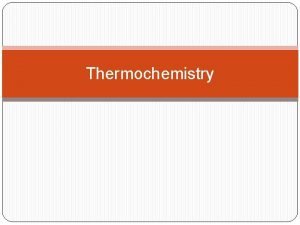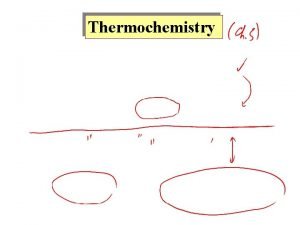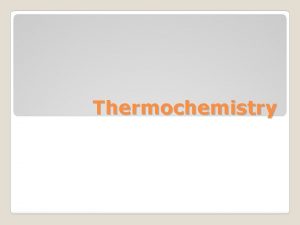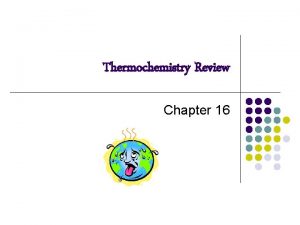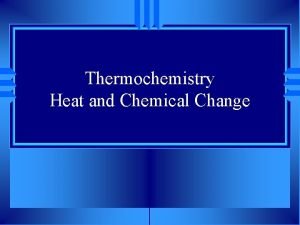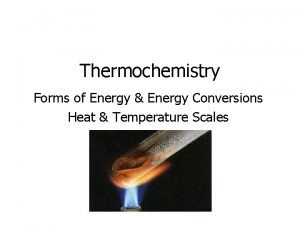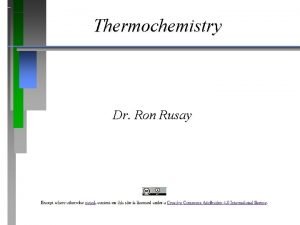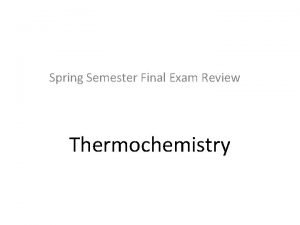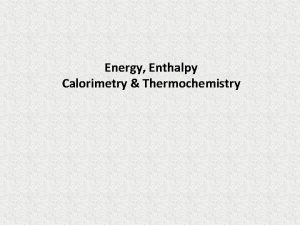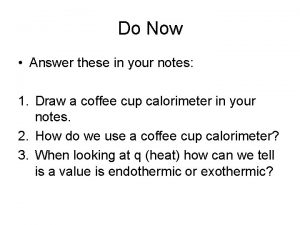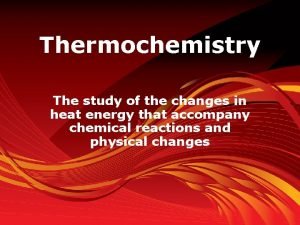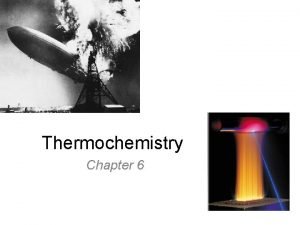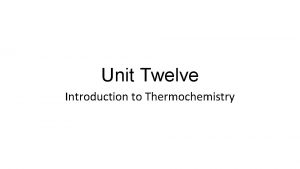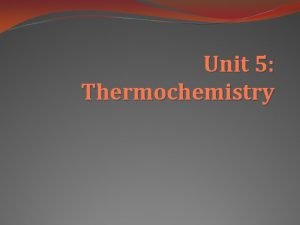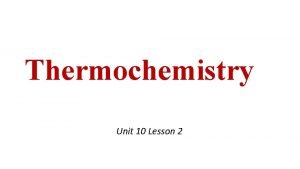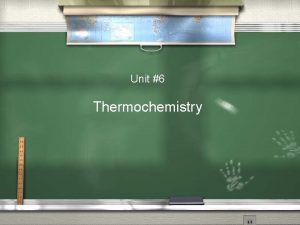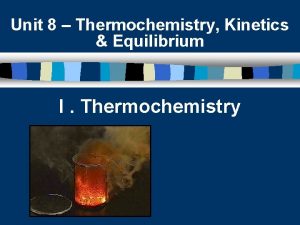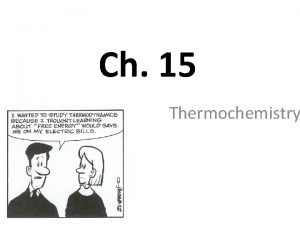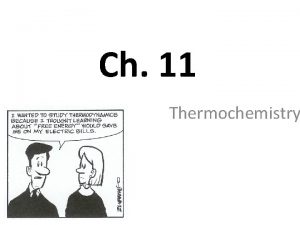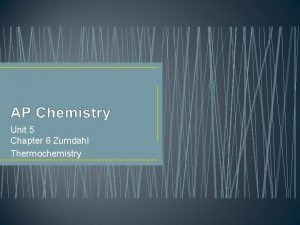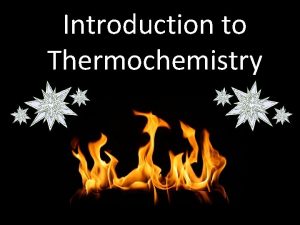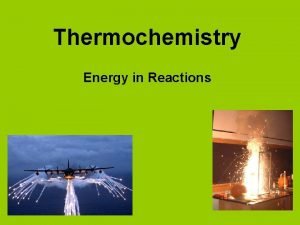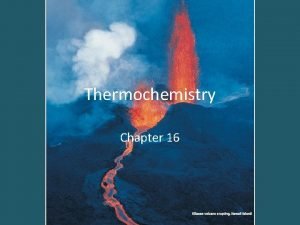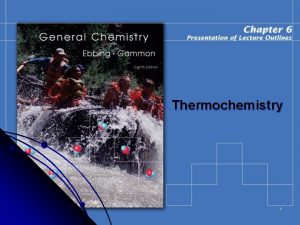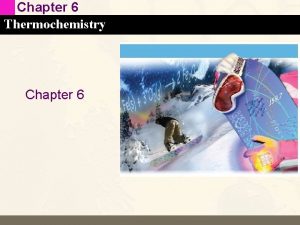Unit 4 Thermochemistry Topics covered The nature of


















































- Slides: 50

Unit 4: Thermochemistry • Topics covered – The nature of energy – The First Law of Thermodynamics – Enthalpy – Calorimetry – Hess’s Law – Enthalpies of formation – Entropy (Second Law of Thermodynamics) – Gibbs free energy

Thermochemistry • Thermodynamics is the study of energy changes • Thermochemistry studies the relationship between chemical reactions and energy changes involving heat

The Nature of Energy • Kinetic energy is the energy of motion – All objects in motion have kinetic energy equal to ½mv 2 (m is mass and v is velocity) – Can two objects with different masses have the same kinetic energy? • Potential energy is stored energy related to the position of an object – A rock balancing on the edge of a cliff has potential energy due to gravity – A stretched rubber band has potential energy due to tension and elasticity • Important to chemistry is electrostatic energy, a form of potential energy between two charged particles, such as protons and electrons – Electrostatic energy is directly proportional to the charge of the particles, but is inversely proportional to the distance between them

Units of Energy • The SI unit for energy is the joule (J) – A joule is defined as a kg m 2/s 2 • A commonly use non-SI unit used for energy is the calorie (cal) – A calorie is defined as the amount of energy needed to raise 1 g of water by 1°C – 1 cal = 4. 184 J (exactly) – A nutritional calorie (Cal) is 1000 calories • 1 Cal = 1000 cal = 1 kcal

System and Surroundings • In thermodynamics, we focus our attention on a limited part of the universe called the system • Everything else is called the surroundings • In a closed system, energy but not matter can be exchanged with the surroundings

The First Law of Thermodynamics • The First Law of Thermodynamics states that energy is conserved, that any energy lost by the system must be gained by the surroundings and vice versa

Endothermic and Exothermic Processes • When a system absorbs heat, the process is called endothermic • A process where the system produces heat is called exothermic • Aqueous reactions can be confusing because often the reactants are considered to be the system and the water is considered part of the surroundings – Water becomes cooler in an endothermic aqueous reaction, warmer in exothermic

Enthalpy • Enthalpy of reaction or heat of reaction ( H or Hrxn) is the heat gained or lost during a chemical reaction – CH 4(g) + 2 O 2(g) CO 2(g) + 2 H 2 O(l) H = -890 k. J – H is negative, so reaction is exothermic – Enthalpy is an extensive property, magnitude of H is proportional to amount of reactant consumed – Because 1 mol of CH 4 and 2 mol of O 2 releases 890 k. J of heat, the combustion of 2 mol of CH 4 with 4 mol O 2 would release twice as much, 1780 k. J

Sample Problem • CH 4(g) + 2 O 2(g) CO 2(g) + 2 H 2 O(l) H = -890 k. J • How much heat is released when 4. 50 g CH 4 is burned at constant pressure?

Sample Problem • CH 4(g) + 2 O 2(g) CO 2(g) + 2 H 2 O(l) H = -890 k. J • How much heat is released when 1. 00 g of water is formed at constant pressure?

Sample Problem • 2 H 2 O 2 2 H 20 + O 2 H = -196 k. J • How much heat is released when 5. 00 g if H 2 O 2 decomposes?

Enthalpy • H is equal in magnitude but opposite in sign for reverse reaction – CH 4 + 2 O 2 CO 2 + 2 H 2 O – CO 2 + 2 H 2 O CH 4 + 2 O 2 H = -890 k. J H = 890 k. J • H depends on phase of reactants and products, therefore it is important to specify states in reactions – 2 H 2 O(l) 2 H 2 O(g) H = +88 k. J

Calorimetry • Calorimetry is measurement of heat flow • A calorimeter is an instrument used to measure heat flow

Specific Heat Capacity • Specific heat capacity (c) is heat needed to raise 1 g of a substance by 1°C • Unit are usually J/g°C • Most of the time we are interested in calculating heat flow

Molar Heat Capacity • Molar heat capacity is the heat capacity of 1 mol of a substance • Units are usually J/mol-K

Specific and Molar Heat Capacities

Specific Heat Capacity • Higher specific heat means temperature is resistant to change – More heat can be absorbed or released without a drastic change in temperature – This is why large bodies of water regulate temperature

Sample Problem • How much heat is needed to warm 250 g H 2 O from 22 C to 98 C?

Sample Problem • What is the molar heat capacity of water?

Constant-Pressure Calorimetry • Assume no heat lost to calorimeter or include calorimeter as part of system and calculate heat capacity of entire system • Heat gained/absorbed by the reaction will be absorbed/gained by the solution

Coffee Cup Calorimeters • Simple constantpressure calorimeters are sometimes called “coffee cup” calorimeters because of the simple materials from which they are made

Sample Problem • Two solutions with a combined mass of 100. 0 g are mixed in a “coffee-cup” calorimeter. The temperature increases from 21. 0 C to 27. 5 C. How much heat was given off by the reaction? Assume no heat is lost to the surroundings and that csoln = 4. 18 J/g K.

Constant Volume Calorimeter (Bomb Calorimeter)***

Sample Problem • Large beds of rocks are used in some solarheated homes to store heat. Assume that the specific heat of the rocks is 0. 82 J/g-K. Calculate the amount of heat absorbed by 50. 0 kg of rocks if their temperature increases by 12 K. What temperature change would they undergo if they emitted 450 k. J of heat?

Sample Problem • Consider the acid-base neutralization that occurs when 0. 050 mol of HCl is completely neutralized with Na. OH in a constant pressure calorimeter: Na. OH(aq) + HCl(aq) H 2 O(l) + Na. Cl(aq). Both solutions are 50. 0 g and are at a temperature of 21. 0 C prior to the reaction. If the final temperature is 27. 5 C what is qrxn? What is ΔHrxn? Assume no heat loss to the surroundings and specific heat the same as pure water.

Hess’s Law • Hess’s law states that if a reaction is carried out in a series of steps, H = sum of enthalpy changes for individual steps – – CH 4(g) + 2 O 2(g) CO 2(g) + 2 H 2 O(g) 2 H 2 O(l) CH 4(g) + 2 O 2(g) + 2 H 2 O(g) CO 2(g) + 2 H 2 O(l) + 2 H 2 O(g) CH 4(g) + 2 O 2(g) CO 2(g) + 2 H 2 O(l) H = -802 k. J H = -88 k. J H = -890 k. J • Equations and H values can be manipulated to solve for unknown enthalpies

Sample Problem • C(s) + O 2(g) CO 2(g) H = -393. 5 k. J • CO(g) + ½O 2(g) CO 2(g) H = -283. 0 k. J • Calculate the enthalpy of combustion of C to CO: C(s) + ½O 2(g) CO(g)

Sample Problem • • C 2 H 2(g) + O 2(g) 2 CO 2(g) + H 2 O(l) H = -1299. 6 k. J C(s) + O 2(g) CO 2(g) H = -393. 5 k. J H 2(g) + ½O 2(g) H 2 O(l) H = -285. 8 k. J Calculate H for: 2 C(s) + H 2(g) C 2 H 2(g)

Enthalpies of Formation • Enthalpy of formation ( ) is the enthalpy change when a compound is formed from its elements – Units are k. J/mol • Standard enthalpy of formation ( ) is when reactants and products are in standard states, i. e. its pure form at 1 atm and 298 K (25 C)

Standard Enthalpy of Formation • 2 C(graphite) + 3 H 2(g) + O 2(g) C 2 H 5 OH(l) – = -277. 7 k. J – Under standard conditions, graphite and diatomic forms are the most stable forms of the elements – The standard enthalpy of formation for the most stable form of any element is zero – Tables of standard enthalpies of formation for most compounds are available

Standard Enthalpy of Reaction • Standard enthalpy of formation can be used to find the enthalpy of a reaction under standard conditions • You must multiply enthalpies by stoichiometric coefficients

Sample Problem • Find the standard enthalpy of reaction for the following: C 3 H 8(g) + 5 O 2(g) 3 CO 2(g) + 4 H 2 O(l)

Sample Problem • Find the standard enthalpy of reaction for the following: C 6 H 6(l) + O 2(g) 6 CO 2(g) + 3 H 2 O(l)

Sample Problem • Find the standard enthalpy of reaction for the combustion of one mol of liquid ethanol, C 2 H 5 OH (assume liquid water is formed)

Spontaneous Processes • Certain processes always occur under a given set of circumstances • Spontaneous processes always have direction – An egg breaking, nail rusting, balloon deflating

Spontaneous Processes • Lowering energy is favorable for spontaneous processes, but cannot be the only factor that determines spontaneity • Some processes depend on temp. – When T > 0 C, ice spontaneously melts – When T < 0 C, water spontaneously freezes • For other processes, energy and temperature do not provide an adequate explanation

Spontaneous Processes • Consider the following: • Why does the gas spontaneously expand, but never spontaneously reverse? • Processes in which the disorder of a system increases tend to occur spontaneously

Entropy • Entropy (S) is the measure of disorder in a system – S = Sfinal – Sinitial – If the disorder of a system increases, S is positive – If disorder decreases, S is negative – Units are J/K

Entropy and Phase Change

Sample Problem • Predict if S is positive or negative – H 2 O(l) H 2 O(g) – Ag+(aq) + Cl-(aq) Ag. Cl(s) – 4 Fe(s) + 3 O 2(g) 2 Fe 2 O 3(s)

Second and Third Laws of Thermodynamics • The second law of thermodynamics states that the entropy of the universe increases with any spontaneous process – Entropy is not conserved – No process that produces order (- S) can proceed without producing equal or greater disorder in its surroundings • The third law of thermodynamics states that the entropy of a pure crystalline substance at 0 K is zero

Entropy Changes in Chemical Reactions • Standard molar entropy (S ) is the molar entropy values of substances in their standard state, units are J/mol K – – S for elements at 298 K is not zero S gas > liquid > solid S generally increases with increasing molar mass S generally increases with increasing number atoms

Sample Problem • Calculate S for synthesis of ammonia gas from hydrogen and nitrogen gas

Sample Problem • Calculate S for the following: Al 2 O 3(s) + 3 H 2(g) 2 Al(s) + 3 H 2 O(g)

Gibbs Free Energy • Gibbs free energy (G) is a function used to predict whether a reaction will be spontaneous – If G is (-), rxn spontaneous in forward dir. – If G is zero, rxn is at equilibrium – If G is (+), rxn is nonspontaneous, work must be done by surroundings, reverse rxn will be spontaneous

Standard Free Energy Changes • All compounds have a standard free energy of formation (ΔG°f)

Sample Problem • Calculate the standard free energy of formation for P 4(g) + 6 Cl 2(g) 4 PCl 3(g) • Is the reaction spontaneous under standard conditions?

Free Energy and Temperature • Temperature often affects whether or not a reactions will be spontaneous ΔG = ΔH – TΔS = ΔH + (-TΔS) • If we assume H and S (which can be easily calculated from tables) do not change with temperature, we can estimate G very accurately at temps. other than 298 K • G = H - T S

Sample Problem • Estimate the values of G at 25 C and 500 C for the Haber process for the production of ammonia: N 2(g) + 3 H 2(g) 2 NH 3(g). At what temperature would the reaction stop being spontaneous?

Sample Problem • Estimate the value of G at 400 K for the following: 2 SO 2(g) + O 2(g) 2 SO 3(g)
 What topics will be covered in this unit
What topics will be covered in this unit Chemistry semester 2 review unit 12 thermochemistry
Chemistry semester 2 review unit 12 thermochemistry Unit 9 thermochemistry
Unit 9 thermochemistry Distance covered per unit time.
Distance covered per unit time. Nature and nature's law lay hid in night meaning
Nature and nature's law lay hid in night meaning Determinace lidské psychiky
Determinace lidské psychiky Unit 6 review questions
Unit 6 review questions Gibbs free energy unit
Gibbs free energy unit Chapter 17 thermochemistry practice problems
Chapter 17 thermochemistry practice problems Thermochemistry is the study of *
Thermochemistry is the study of * Thermochemistry is study of
Thermochemistry is study of Radiant solar energy
Radiant solar energy Introduction to thermochemistry
Introduction to thermochemistry Thermochemistry gaussian
Thermochemistry gaussian Thermochemical equation
Thermochemical equation Thermochemistry clipart
Thermochemistry clipart Thermochemistry is a study of
Thermochemistry is a study of Thermochemistry equations
Thermochemistry equations Symbolic border one pager
Symbolic border one pager Thermochemical equation examples
Thermochemical equation examples Kirchhoff's law enthalpy example
Kirchhoff's law enthalpy example Chapter 17 thermochemistry
Chapter 17 thermochemistry Thermochemistry equations
Thermochemistry equations Thermochemistry cartoon
Thermochemistry cartoon Ap chemistry thermodynamics
Ap chemistry thermodynamics Ap chemistry unit 7
Ap chemistry unit 7 Thermochemistry is the study of *
Thermochemistry is the study of * General chemistry thermochemistry
General chemistry thermochemistry Thermochemistry notes form 3
Thermochemistry notes form 3 Study of energy transformations
Study of energy transformations Chapter 17 thermochemistry answer key
Chapter 17 thermochemistry answer key Entalpi pengatoman standar
Entalpi pengatoman standar What is thermochemistry
What is thermochemistry What is thermochemistry
What is thermochemistry Chapter 17 thermochemistry
Chapter 17 thermochemistry Thermochemistry concepts
Thermochemistry concepts Thermochemistry is the study of
Thermochemistry is the study of Energy diagram thermochemistry
Energy diagram thermochemistry Thermochemistry is concerned with the
Thermochemistry is concerned with the Kinetic energy thermochemistry
Kinetic energy thermochemistry Thermochemistry
Thermochemistry Thermochemistry review
Thermochemistry review Bomb calorimetry equation
Bomb calorimetry equation Thermochemistry video
Thermochemistry video Thermochemistry intro and joule conversions
Thermochemistry intro and joule conversions Thermochemistry
Thermochemistry Thermochemistry exam review
Thermochemistry exam review State and explain hess's law of constant heat summation.
State and explain hess's law of constant heat summation. Thermochemistry notes
Thermochemistry notes Thermochemistry
Thermochemistry Thermochemistry problems
Thermochemistry problems


